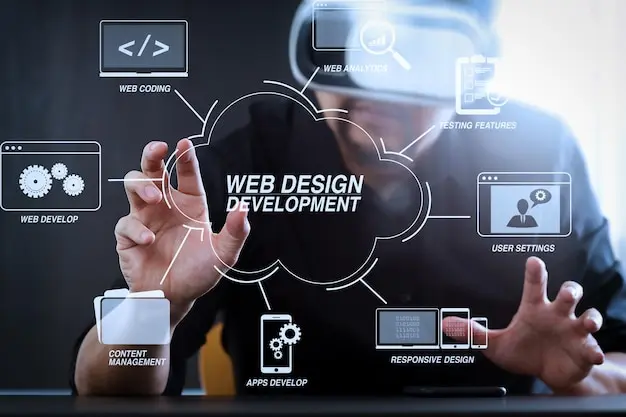The future of web development is an exciting frontier that promises to redefine how we interact with the digital world. As technology evolves at an unprecedented pace, web developers are at the forefront of creating innovative, user-centric, and high-performing websites. From artificial intelligence to immersive experiences, the landscape of web development is shifting, and staying ahead of these changes is key to thriving in this dynamic industry.
In this blog, we’ll explore the emerging trends, tools, and technologies that are shaping the future of web development. Whether you're a seasoned developer or just starting out, understanding these shifts will help you adapt and excel in the ever-evolving web ecosystem.
The Rise of Artificial Intelligence in Web Development
Artificial intelligence (AI) is no longer a distant dream—it’s a driving force in the future of web development. AI-powered tools are streamlining workflows, automating repetitive tasks, and enhancing user experiences. Chatbots, for instance, are becoming smarter, providing real-time customer support, while AI-driven design platforms can generate layouts based on user preferences.
Beyond automation, AI is enabling personalized web experiences. Websites can now analyze user behavior and adapt content dynamically, making every visit unique. As AI continues to evolve, its role in the future of web development will only grow, offering developers new ways to create intelligent, responsive sites.
Sub-Heading: Machine Learning and Predictive Analytics
Machine learning, a subset of AI, is another game-changer. By integrating predictive analytics, websites can anticipate user needs—think product recommendations or tailored search results. This not only boosts engagement but also sets the stage for the future of web development, where data-driven decisions reign supreme.
Progressive Web Apps (PWAs): The Next Big Thing
Progressive Web Apps (PWAs) are revolutionizing how we think about web accessibility. Blurring the line between websites and mobile apps, PWAs offer fast loading times, offline functionality, and a seamless user experience. As mobile usage continues to dominate, PWAs are a cornerstone in the future of web development.
Businesses are adopting PWAs to enhance performance and reduce bounce rates. With features like push notifications and home-screen installation, PWAs provide app-like experiences without the need for downloads, making them a must-know technology for developers looking to shape the future.
The Impact of Web Assembly on Performance
Speed is everything in today’s digital age, and Web Assembly (Wasm) is paving the way for lightning-fast websites. By allowing developers to run high-performance code in browsers, Web Assembly is a critical piece of the future of web development. It’s especially useful for resource-intensive applications like games, video editors, and virtual reality experiences.
Unlike traditional JavaScript, Web Assembly offers near-native performance, making it a powerful tool for developers. As browsers continue to optimize Wasm support, its adoption will skyrocket, driving the future of web development toward faster, more efficient web solutions.
Sub-Heading: Web Assembly and Cross-Platform Development
Another advantage of Web Assembly is its potential for cross-platform compatibility. Developers can write code once and deploy it across multiple environments, saving time and resources. This versatility ensures Web Assembly’s place in the future of web development as a go-to technology.
Immersive Experiences with AR and VR
Augmented Reality (AR) and Virtual Reality (VR) are no longer confined to gaming—they’re transforming the web. Imagine shopping websites where you can “try on” clothes or real estate platforms offering virtual tours. These immersive technologies are defining the future of web development by creating engaging, interactive experiences.
While AR and VR are still emerging, tools like WebXR are making it easier for developers to integrate them into websites. As hardware becomes more accessible, expect these technologies to become mainstream, pushing the boundaries of what’s possible on the web.
Sustainability and Green Web Development
Sustainability is a growing concern across industries, and web development is no exception. The future of web development will prioritize eco-friendly practices, such as optimizing code for energy efficiency and reducing server loads. Green hosting solutions and lightweight frameworks are gaining traction as developers strive to minimize their digital carbon footprint.
By adopting sustainable practices, developers can contribute to a healthier planet while maintaining top-tier performance. This ethical shift is a subtle yet impactful trend in the future of web development.
The Role of Low-Code and No-Code Platforms
The rise of low-code and no-code platforms is democratizing web development. These tools allow non-technical users to build websites with drag-and-drop interfaces, reducing reliance on traditional coding. While some fear this might threaten jobs, it’s more likely to reshape the future of web development by empowering developers to focus on complex, creative tasks.
For professionals, low-code solutions can speed up prototyping and deployment, making workflows more efficient. As these platforms evolve, they’ll play a complementary role in the future of web development, bridging the gap between novices and experts.
The future of web development is a blend of innovation, accessibility, and sustainability. From AI and WebAssembly to PWAs and immersive technologies, the tools and trends discussed here are just the beginning. Developers who embrace these changes will not only stay relevant but also lead the charge in crafting the next generation of websites.
